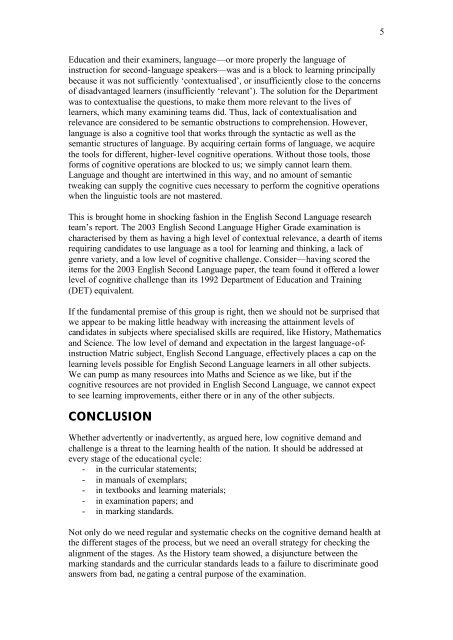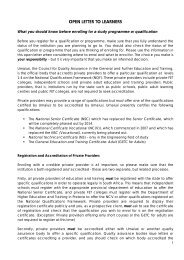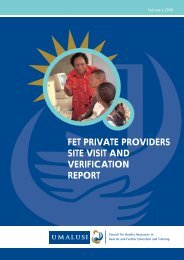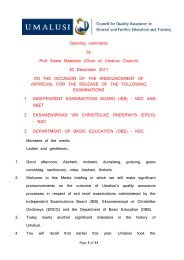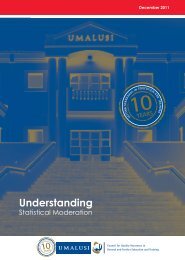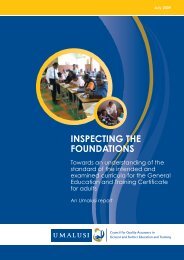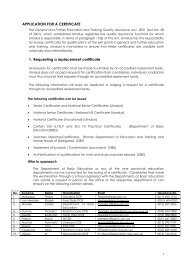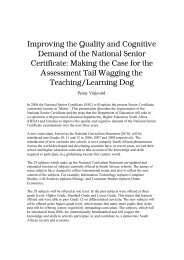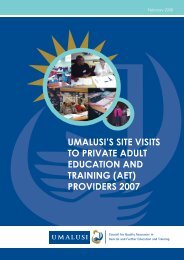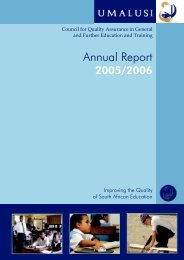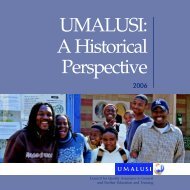The Challenge of Cognitive Demand - Umalusi
The Challenge of Cognitive Demand - Umalusi
The Challenge of Cognitive Demand - Umalusi
Create successful ePaper yourself
Turn your PDF publications into a flip-book with our unique Google optimized e-Paper software.
5Education and their examiners, language—or more properly the language <strong>of</strong>instruction for second-language speakers—was and is a block to learning principallybecause it was not sufficiently ‘contextualised’, or insufficiently close to the concerns<strong>of</strong> disadvantaged learners (insufficiently ‘relevant’). <strong>The</strong> solution for the Departmentwas to contextualise the questions, to make them more relevant to the lives <strong>of</strong>learners, which many examining teams did. Thus, lack <strong>of</strong> contextualisation andrelevance are considered to be semantic obstructions to comprehension. However,language is also a cognitive tool that works through the syntactic as well as thesemantic structures <strong>of</strong> language. By acquiring certain forms <strong>of</strong> language, we acquirethe tools for different, higher-level cognitive operations. Without those tools, thoseforms <strong>of</strong> cognitive operations are blocked to us; we simply cannot learn them.Language and thought are intertwined in this way, and no amount <strong>of</strong> semantictweaking can supply the cognitive cues necessary to perform the cognitive operationswhen the linguistic tools are not mastered.This is brought home in shocking fashion in the English Second Language researchteam’s report. <strong>The</strong> 2003 English Second Language Higher Grade examination ischaracterised by them as having a high level <strong>of</strong> contextual relevance, a dearth <strong>of</strong> itemsrequiring candidates to use language as a tool for learning and thinking, a lack <strong>of</strong>genre variety, and a low level <strong>of</strong> cognitive challenge. Consider—having scored theitems for the 2003 English Second Language paper, the team found it <strong>of</strong>fered a lowerlevel <strong>of</strong> cognitive challenge than its 1992 Department <strong>of</strong> Education and Training(DET) equivalent.If the fundamental premise <strong>of</strong> this group is right, then we should not be surprised thatwe appear to be making little headway with increasing the attainment levels <strong>of</strong>candidates in subjects where specialised skills are required, like History, Mathematicsand Science. <strong>The</strong> low level <strong>of</strong> demand and expectation in the largest language-<strong>of</strong>instructionMatric subject, English Second Language, effectively places a cap on thelearning levels possible for English Second Language learners in all other subjects.We can pump as many resources into Maths and Science as we like, but if thecognitive resources are not provided in English Second Language, we cannot expectto see learning improvements, either there or in any <strong>of</strong> the other subjects.CONCLUSIONWhether advertently or inadvertently, as argued here, low cognitive demand andchallenge is a threat to the learning health <strong>of</strong> the nation. It should be addressed atevery stage <strong>of</strong> the educational cycle:- in the curricular statements;- in manuals <strong>of</strong> exemplars;- in textbooks and learning materials;- in examination papers; and- in marking standards.Not only do we need regular and systematic checks on the cognitive demand health atthe different stages <strong>of</strong> the process, but we need an overall strategy for checking thealignment <strong>of</strong> the stages. As the History team showed, a disjuncture between themarking standards and the curricular standards leads to a failure to discriminate goodanswers from bad, negating a central purpose <strong>of</strong> the examination.


